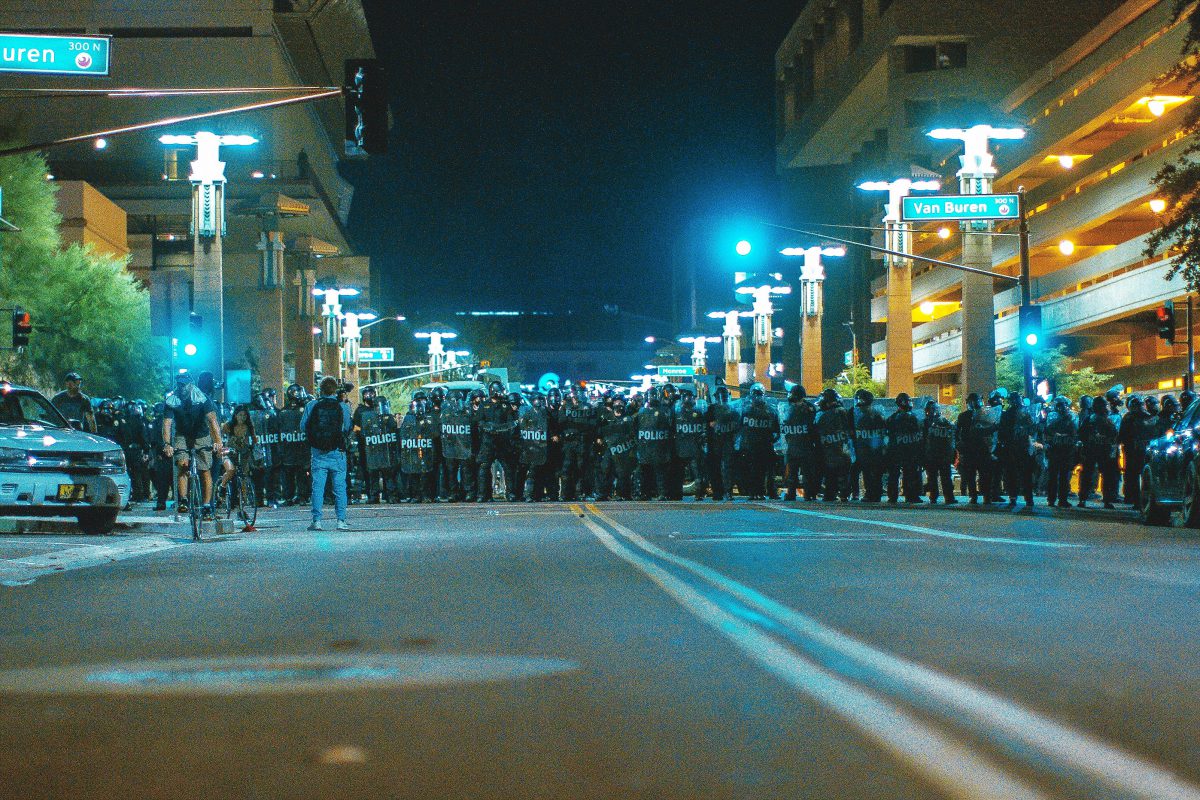Art and Culture
Blame Modern Life for Political Strife
Without voluntary associations, we tend to reduce unfamiliar individuals down to a set of salient features.

It’s hard to argue against the comforts of modernity. Avocado toast, fiber optics, Roombas. What’s not to love? Technological innovation and trade liberalization have yielded prosperity and stability. Poverty, infant mortality, and global hunger have fallen. Human development, life expectancy, and food production have risen. Compared to our ancestors, we’re the glitterati.
But there are always tradeoffs. While urbanization and personal accumulation have enriched the West, they have also produced a culture of narcissism and illusion of time scarcity. This self-preoccupation and feeling of lost leisure time has reduced our participation in civic organizations. We’re engaging less with one another. And as a consequence, societal trust has dissipated. This has inhibited the development of common interests and shared identities, prompting a return to an archaic tribalism which prioritizes salient features over ideological values.
You People are All the Same
Imagine you were speaking to someone you’ve never met. Both of you are separated by a dark curtain to conceal appearances and voices have been distorted to obscure genders. The first and only thing they mention is that they’re a Republican. What might this person look like? Chances are you weren’t picturing someone black, female, gay, or non-religious. What if they said Democrat? Did you picture a white Christian male? Not likely, we’d wager. Out of many possible combinations, you have intuitive ideas about who sides with what party.
Here’s the secret about modern political tribalism: it has little to with policy or ideology. In fact, research suggests that political identities are weak predictors of policy preferences with Americans routinely overestimating the policy preferences of Republicans and Democrats.
In reality, modern political tribalism appears to be a vehicle for more conventional forms of tribalism. It is driven by differences of race, religion, geography, gender, and class, but is conveniently housed within the confines of a political contest. The reason for this is that our social identities have coalesced, aligning with our political identities. Put differently, our political preferences are becoming strong indicators of our race, religion, sexual orientation, and gender.
What’s more, the American electorate has separated into two increasingly homogenous political tribes. As Lilliana Mason points out in Uncivil Agreement, “partisanship can now be thought of as a mega-identity.” The Republican mega-identity is religious, middle-class, rural, and white. The Democrat mega-identity is secular, working class, urban, non-white, and gay. But perceptions about group homogeneity can clash with reality.
Take a recent study where researchers asked Americans to estimate the size of groups in each party. Respondents believed 31.7% of Democrats were members of the LGBT community. The actual number: 6.3%. As for Republicans, they believed that 38.2% earned over $250,000 per year. The actual number: 2.2%. Both parties have warped views of the other.
Part of this can be explained by the out-group homogeneity effect. Simply put, we tend to believe that members of our own groups are unique, while those in unfamiliar groups are the same. For the out-group, we generalize, we stereotype, and we denigrate. For our in-group, we pay special attention to each member’s unique attributes, mental states, and contradictions. One study found that participants assigned fewer mental attributes to “a group of people” relative to “people in a group.” When we focus on group membership, we are more likely to strip people of their capacity to think and feel. By painting an out-group with a broad brush, we reduce our burden of having to think of people as individuals. We default to our biases.
Perceptions, false or otherwise, have an insidious habit of determining reality. In this case, Americans are convinced that they are locked in a political grudge match against a homogeneous tribe of outsiders.
As a result, Republicans and Democrats are increasingly unwilling to get married, be friends, or live beside one another. In 1960, only 5% of Republicans and 4% of Democrats disapproved of their child marrying outside their party. In 2014, 30% of Republicans and 23% of Democrats disapproved of inter-party marriage. Compare this to interracial marriage, a former taboo. According to Gallup, 87% of Americans now favor interracial marriage, up from 4% in 1958.
Along the same lines, 63% of Republicans and 49% of Democrats report being friends primarily with those sharing their political views. Another nationally representative study found that 20% of Democrats and 15% of Republicans believe that their country would be better off if large numbers of people in the other party died. We’ve traded one prejudice for another.
Part of these changes is due to the reduction of “cross-cutting cleavages.” These are shared identities that are present in one social group but also in others. For example, rival fan bases will support their hometown team, but will also unite to support their nation’s Olympic team.

Political scientists have long held that the effects of partisanship are dampened by cross-cutting cleavages. Mutual social ties provide a sort of common ground from which political rivals can collaborate. A wealthy Republican can find common ground with a working-class Democrat if they both attend the same church.
But the sorting of American social groups into two political tribes has reduced our cross-cutting ties. When we identify most with our political parties, our shared identities fade into the background. Under these conditions, communication collapses, trust dissipates, and hostilities intensify.
The Busy and the Boastful
Modern society can be cold, contained, and isolating. Industry and urbanization, while pivotal to our species’ success, altered human relations. Emphasis on personal accumulation has encouraged individual decision-making, weakening the role and relevance of our tribes in everyday affairs. This shift in human relations had two major effects; it (1) it transformed our adaptive values and (2) it distorted our perception of time. Tribal connectivity began to erode.
The transition from rural to urban, as psychologist Patricia Greenfield suggests, transformed the adaptive values of Western culture. Using Google’s Ngram Viewer to measure word usage in American and English literature between 1800 and 2000, Greenfield observed increases in words like “get,” “ego,” and “self,” and decreases in words like “give,” “obedience,” and “belong.” The individual had triumphed over faith, family, and community. Still, the problem isn’t individualism so much as it is a pathological preoccupation with the self.

As social psychologists Jean Twenge and W. Keith Campbell explain in The Narcissism Epidemic, American culture has, for the past 50 years, experienced a shift towards narcissism.
In data from 37,000 college students, narcissistic personality traits rose just as fast as obesity from the 1980’s to the present. “By 2006, two-thirds of college students scored above the scale’s original 1979–85 sample average, a 30% increase in only two decades.” In fact, one study found a statistically significant trend toward narcissism in music, with researchers observing the gradual replacement of the words “we” and “us” with “I” and “me”.
Economic development and cultural environment are intertwined; with the former often determining the latter’s orientation towards individualism or collectivism. And this influences personality traits. America’s move towards narcissism began in the late 1960s with the college Boomers, but accelerated under the economic opulence of the 1980s. During this period, almost every trait related to narcissism increased. Of course, the consequences of extreme collectivism are appalling. But an extreme emphasis on self-satisfaction can also be damaging to a culture. Narcissism may come to resemble a social value.
Then there’s modernity’s effect on leisure time. While John Maynard Keynes’s prediction of a 15-hour work week has not materialized, he was on the right track. Leisure times have increased. In fact, we’re working less than we did in the 1960s and considerably less than we did under an agrarian economy. Men work 12 hours fewer each week compared to 40 years ago. And while women’s paid work has increased, their time spent on housework and childcare has declined by 35 percent.
But here’s the weird part: we don’t actually think we’re working less. According to Gallup, 28 percent of Americans feel they don’t have enough time to finish what they need to. A similar study of 2000 workers in Britain revealed that 70 percent of respondents felt that their lives were “too busy.” Our perception of time has been distorted. But why?

As economies grow and incomes rise, time becomes more valuable. Individualistic cultures, which prize accumulation over affiliation, cultivate this time-is-money mindset. We want to make every moment count. And as The Economist points out, “when people see their time in terms of money, they often grow stingy with the former to maximize the latter.”
In an experiment by management scholars Sanford DeVoe and Julian House, two groups were asked to listen to the first 86 seconds of “The Flower Duet”. However, one group was asked to think about their hourly wage while they listened. This group was more impatient and less relaxed than the group that wasn’t thinking about money. As Dr. DeVoe maintains, “they wanted to get to the end of the experiment to do something that was more profitable.”
While economic progress has improved our standard of living, it has also created an illusion of time scarcity. Labor economist Daniel Hamermesh refers to this as the “yuppie kvetch” — a phenomenon where the cash-rich feel time-poor.
Then there are the ways new technology is changing us. According to psychologist Aoife McLoughlin, constant interaction with technology has disrupted the natural pacemaker within us. “Those who were always online or on their computers or smartphones overestimated the amount of time that had passed compared to those who rarely used technology.” To make matters worse, 60 percent of those who use smartphones are connected to work for 13.5 hours each day. We’re more dialed in, but less aware of the passage of time.
Under the forces of narcissism and perceived time-scarcity, our social connections falter. We’re too busy and too self-important to tend to others. For journalist and documentarian Sebastian Junger, the mechanism is simple: the poor are forced to share their time and resources and the rich are not. The challenges of poverty demand cooperation and interdependence. For the affluent, though, a shared struggle does not exist. Financial independence is freedom from the tribe.
But without a tribe we run the risk of social isolation and a loss of self. As sociobiologist E. O. Wilson writes, “to be kept in solitude is to be kept in pain…a person’s membership in his group—his tribe—is a large part of his identity.”

According to a Cigna survey of more than 20,000 Americans, 54 percent of respondents sometimes or always felt that no one knew them well. In fact, 56 percent felt that those around them were not “necessarily with them.” In Britain, the statistics tell a similar tale. In 2018, the Red Cross declared loneliness a “hidden epidemic” with over 9 million Britons reporting that they often or always felt lonely. The severity of social isolation is such that Britain has appointed a “Minister of Loneliness”. Modern life, rewarding as it is, has impaired our social connections.
The Strange Death of Social Capital
In Bowling Alone, political scientist Robert Putnam suggests that voluntary organizations have, for the past 50 years, experienced a precipitous decline in membership. And it wasn’t that old members were dropping out. Rather, younger members were choosing not to join.
In 1975, American men and women attended 12 club meetings a year. By 1999, it dropped to five. In terms of hours per month, the average American’s investment in organizational life had fallen from 3.7 hours per month in 1965 to 2.3 in 1995. This trend accelerated after 1985 as active involvement in community organizations fell by 45 percent. By this measure, nearly half of America’s civic infrastructure was obliterated in a decade.
According to Putnam, this decline in civil engagement created a laceration in American social life. Social capital had collapsed.
“Social capital refers to connections among individuals—social networks and the norms of reciprocity and trustworthiness that arise from them.” Broadly, social capital is a civic virtue based on a general trust in others. Good will, sympathy, fellowship; these are the properties of social capital.
For Putnam, community organizations generate social capital. They connect individuals and create trust. In this regard, civic institutions foment a healthy tribalism based on voluntary association. Membership is contingent not on physical features but on personal interests. But perhaps most importantly, civic institutions create cross-cutting cleavages. Members of formerly adversarial social groups can join together if both are members of the same voluntary association.
Moreover, Putnam contends that the decline in social capital can be explained by four possible factors: the pressures of time and money, suburbanization and commuting, electronic entertainment, and generational turnover. While each explanation is unique, they share a common feature: all are products of modernity.
Putnam’s explanations are related to the two we’ve proposed. The pressures of time and money, suburbanization and commuting, and electronic entertainment are tied to the economic developments which have distorted our perception of time. And generational turnover means values have changed. Younger people are more focused on themselves and less focused on civic institutions.
We think ourselves too busy or too important to attend religious services, volunteer, or participate in community organizations. As a result, cross-cutting cleavages have evaporated. Without civic engagement, shared identities and common interests atrophy or fail to develop. We lose track of unifying elements.
And indeed, there has been a sharp decline in various forms of informal social engagement over the past 50 years. According to Putnam, visiting with friends, meals with family, and get-togethers at bars and nightclubs have decreased by 35 percent, 43 percent, and 45 percent, respectively. In fact, we’re growing increasingly unfamiliar with those around us. According to Pew Research, 57 percent of Americans knew some or none of their neighbors by name.
Under these conditions, trust dissipates. We default to our biases when dealing with unfamiliar people, treating them with skepticism and sometimes malice. A 2013 poll by the Associated Press revealed that only 1 in 3 Americans would agree that “most people can be trusted.” Furthermore, sociologist Josh Morgan found that “the percentage of all respondents who said that most people can be trusted dropped from about 46 percent in 1972 to about 32 percent in 2012.”
For people to coexist, trust is required. And cross-cutting cleavages are essential for this. Without them, we will seek out other measures of trust. Archaic forms of tribalism may emerge.

Tribal Relapse
A reduction in civil engagement doesn’t just diminish tribal connectivity. It redirects it. Tribalism is inevitable. And the collapse of social capital provokes a scramble to compensate and direct our social energy elsewhere.
Trust and association go hand in hand. We associate with those we trust. And we trust those we associate with. But in the absence of civic organizations, we develop different means of conferring trust upon the unfamiliar.
Without voluntary associations, we tend to reduce unfamiliar individuals down to a set of salient features. When we don’t have the time or interest to get to know one another, we resort to cheap and easy methods of identification. We default to our biases about race, ethnicity, gender, religion, and sexual orientation. The calculus for this method is simple yet disturbing: “I trust this person because they look or think like me.”
And as is often the case, we choose to live beside those who look and think like us. Consider Americans’ geographical realignment following the collapse of social capital. According to political scientists Andrew Garner and Harvey Palmer, American residential neighborhoods became increasingly balkanized by “political attitudes as well as . . . race, education, and income.”
This drive to be amongst one’s “own people” is supported the scientific literature. Research shows that we automatically encode three features when we meet someone for the first time: age, sex, and race. The first two make evolutionary sense. Our ancestors distinguished between old and young, and male and female for the purposes of status, reproduction, and kinship. But race is different. Our ancestors traveled by foot, and almost never encountered another tribe whose “race” differed from theirs.
Nevertheless, Robert Kurzban and his colleagues suggest that race is only important insofar as it signals group membership. We typically use visual cues to determine who is from what tribe. In foraging societies, this might include hairstyles, piercings, and other adornments. As race is a salient feature, it signals tribal affiliations similar to how sports jerseys separate rival fan bases.
Or consider psychologist David Kelly’s work on in-group recognition among three-month olds. As Paul Bloom writes, sharing Kelly’s findings, “Ethiopian babies prefer to look at Ethiopian faces rather than Caucasian faces; Chinese babies prefer to look at Chinese faces rather than Caucasian or African faces.” At an early age, then, we attribute value to familiarity. We have an ingrained preference for what we easily recognize.
Eliminating the Out-group
The Republican and Democratic mega-identities are a consequence of our return to an archaic tribalism which prioritizes salient features over political or civic values. Political observers have referred to this as “identity politics,” a seemingly new phenomenon. But that’s not actually true. As Jonah Goldberg contends, “‘Identity politics’ may be a modern term, but it is an ancient idea. Embracing it is not a step forward but a retreat to the past.”
Looking beyond visible traits and treating others as individuals is a recent idea. But we often fall short of it. We group individuals together based on their superficial characteristics. This comes easily to us. And when something comes easy, we will find all kinds of reasons to justify why it’s right.
We are now in the precarious position of moving back toward this way of thinking, of folding people into categories. We want to easily understand who our allies and enemies are. The desire for an out-group is ever present. Today, the safest way to express this desire is through political parties, which appear to be vehicles for other social identities. Unfortunately, one of the surest ways to obtain social status in our in-groups is to denigrate our out-groups.
So we have a choice: we can repair our country by engaging with those with whom we politically disagree. Or we can trash our political opponents to boost our social status at the cost of destroying the country.
Just because something’s easy doesn’t make it right. Sometimes we have to walk a road less traveled. There’s another way to eliminate your out-group: make them your in-group by finding shared values. We must create new cross-cutting ties.






